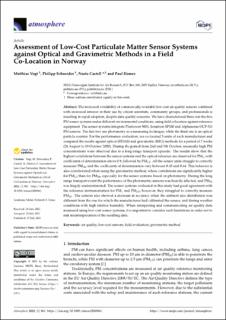| dc.contributor.author | Vogt, Matthias | |
| dc.contributor.author | Schneider, Philipp | |
| dc.contributor.author | Castell, Nuria | |
| dc.contributor.author | Hamer, Paul David | |
| dc.date.accessioned | 2021-08-10T08:50:00Z | |
| dc.date.available | 2021-08-10T08:50:00Z | |
| dc.date.created | 2021-08-09T13:09:34Z | |
| dc.date.issued | 2021 | |
| dc.identifier.citation | Atmosphere. 2021, 12, 961. | en_US |
| dc.identifier.issn | 2073-4433 | |
| dc.identifier.uri | https://hdl.handle.net/11250/2767129 | |
| dc.description.abstract | The increased availability of commercially-available low-cost air quality sensors combined with increased interest in their use by citizen scientists, community groups, and professionals is resulting in rapid adoption, despite data quality concerns. We have characterized three out-the-box PM sensor systems under different environmental conditions, using field colocation against reference equipment. The sensor systems integrate Plantower 5003, Sensirion SPS30 and Alphasense OCP-N3 PM sensors. The first two use photometry as a measuring technique, while the third one is an optical particle counter. For the performance evaluation, we co-located 3 units of each manufacturer and compared the results against optical (FIDAS) and gravimetric (KFG) methods for a period of 7 weeks (28 August to 19 October 2020). During the period from 2nd and 5th October, unusually high PM concentrations were observed due to a long-range transport episode. The results show that the highest correlations between the sensor systems and the optical reference are observed for PM1, with coefficients of determination above 0.9, followed by PM2.5. All the sensor units struggle to correctly measure PM10, and the coefficients of determination vary between 0.45 and 0.64. This behavior is also corroborated when using the gravimetric method, where correlations are significantly higher for PM2.5 than for PM10, especially for the sensor systems based on photometry. During the long range transport event the performance of the photometric sensors was heavily affected, and PM10 was largely underestimated. The sensor systems evaluated in this study had good agreement with the reference instrumentation for PM1 and PM2.5; however, they struggled to correctly measure PM10. The sensors also showed a decrease in accuracy when the ambient size distribution was different from the one for which the manufacturer had calibrated the sensor, and during weather conditions with high relative humidity. When interpreting and communicating air quality data measured using low-cost sensor systems, it is important to consider such limitations in order not to risk misinterpretation of the resulting data. | en_US |
| dc.language.iso | eng | en_US |
| dc.rights | Navngivelse 4.0 Internasjonal | * |
| dc.rights.uri | http://creativecommons.org/licenses/by/4.0/deed.no | * |
| dc.title | Assessment of Low-Cost Particulate Matter Sensor Systems against Optical and Gravimetric Methods in a Field Co-Location in Norway | en_US |
| dc.type | Peer reviewed | en_US |
| dc.type | Journal article | en_US |
| dc.description.version | publishedVersion | en_US |
| dc.rights.holder | © 2021 by the authors. Licensee MDPI, Basel, Switzerland. | en_US |
| dc.source.volume | 12 | en_US |
| dc.source.journal | Atmosphere | en_US |
| dc.identifier.doi | 10.3390/atmos12080961 | |
| dc.identifier.cristin | 1924728 | |
| dc.relation.project | Norges forskningsråd: 284931 | en_US |
| dc.relation.project | NILU - Norsk institutt for luftforskning: 118108 | en_US |
| dc.source.articlenumber | 961 | en_US |
| cristin.ispublished | true | |
| cristin.fulltext | original | |
| cristin.qualitycode | 1 | |

